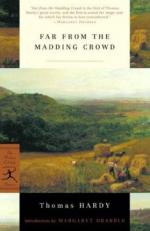|
This section contains 8,341 words (approx. 28 pages at 300 words per page) |

|
SOURCE: Selby, Keith. “Hardy, History and Hokum.” In The Classic Novel: From Page to Screen, edited by Robert Giddings and Erica Sheen, pp. 93-113. Manchester: Manchester University Press, 2000.
In the following essay, Selby examines screen adaptations of Far from the Madding Crowd by John Schlesinger and Tess of the d'Urbervilles by Roman Polanski, finding that the directors take liberties with Hardy's version of history and his interpretation of character.
It was David Lodge, in an early article on The Return of the Native (1878), who first called Hardy a ‘cinematic’ novelist—by which he meant not that Hardy was influenced by film (even Hardy's last novel, Jude the Obscure (1896), was published well before film had properly evolved as a narrative medium), but rather that he emulated it. Lodge writes:
Hardy uses verbal description as a film director uses the lens of his camera—to select, highlight, distort, and enhance...
|
This section contains 8,341 words (approx. 28 pages at 300 words per page) |

|


